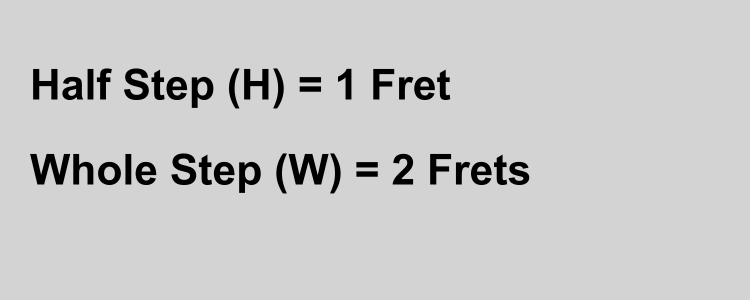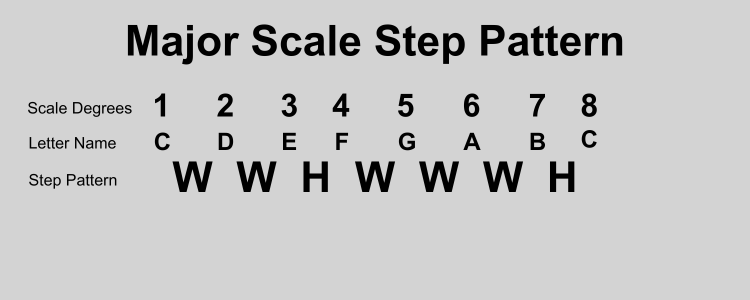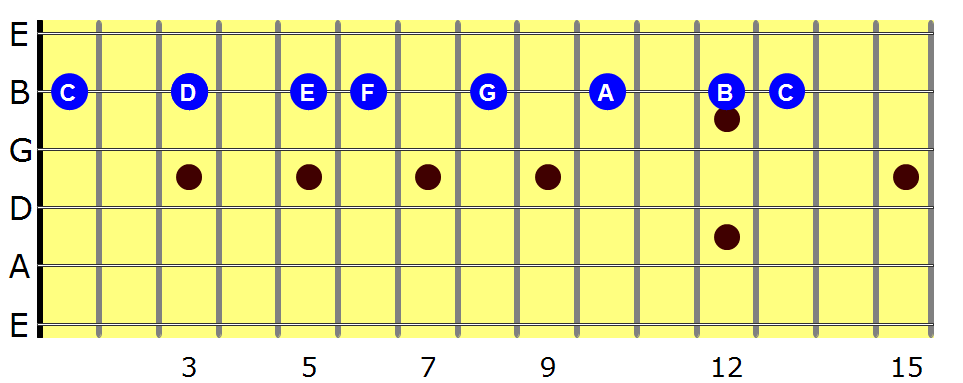Do you want to know how to build the major scale on guitar? Congratulations, you have come to the right place! No need to go anywhere else. This post will cover all the major scales for all 15 major key signatures. We’ll discuss the scale and its importance, why you need to know it, and how to build it.
Before I tell you how to build a major scale, I’d like to tell you why you would want to. Understanding the major scales can increase your knowledge of the fretboard. Major scale knowledge is also crucial for understanding chord construction in the future.
Tip: Consider reviewing the guitar notes in the first position if you don’t know them already.
What is a scale? A scale is a collection of notes arranged by pitch in ascending or descending order. A scale usually forms a progression between a note and its octave. In the last two hundred years, the major and minor scales have been the most used in Western music by far.
In this article, we will focus on the major scale. The major scale contains seven different pitches. Each pitch has a letter name. The eighth letter name is the same as the first but is an octave higher or lower.
For example, c major in ascending order would look like…C, D, E, F, G, A, B, and C. Each pitch in the scale is a scale degree.
The scale degrees must follow a particular pattern to form a major scale.
Whole (W) and Half (H) Steps
On the guitar, a half step is a distance of one fret. A whole step equals two half steps. A whole step is the distance of two frets on a guitar.

Increasing the pitch of a note by a half step will sharpen the note. Decreasing the pitch by a half step will flatten the note.
The Major Scale pattern
We build a major scale by following a specific pattern of the Whole (W) and Half (H) steps. The pattern looks like this…WWHWWWH. C major is the only major scale that does not contain sharps or flats.

Tip: When you practice building the major scale consider the following practice tips. The next major scale rule is useful for scale construction.
MAJOR SCALE RULE – Half steps always fall between degrees 3 and 4, and 7 and 8. The space between all other scale degrees is a whole step.
The major scale would look like this across the B string (2nd string).

Now that we got the hang of C major, let’s move on to the other keys!
Major Scale Degree Names
1st degree – Tonic – This is the tonal center. It’s the same letter as the name of the scale.
2nd degree – Supertonic – One whole step above the tonic.
3rd degree – Mediant – Midpoint between the first and fifth degrees.
4th degree – Subdominant – The fifth tone down from the tonic and the fourth tone up from the tonic.
5th degree – Dominant – has the strongest relationship to the tonic of all the scale degrees.
6th degree – Submediant – Third tone down from the tonic and sixth tone up from the tonic.
7th degree – Leading Tone – Resides one-half step below the tonic. This strongly leads to the tonic.
C major scale
C major is the only key with no sharps or flats in its key signature. The major scale step pattern looks like this.

On the staff and tablature…

G major scale
G major has one sharp in its key signature. F# on the leading tone (seventh scale degree). The major scale step pattern looks like this.

On the staff and tablature…

D major
D major has two sharps in its key signature. There is an F# on the third scale degree (the mediant), and a C# on the leading tone (seventh scale degree). Its major scale step pattern looks like this.

On the staff and tablature…

A major
A major has three sharps in its key signature. C# on the mediant, F# on the sixth scale degree, and G# on the leading tone. The major scale step pattern looks like this.

On the staff and tablature…

E major
E major has four sharps in its key signature. F# on the second scale degree, G# on the mediant, C# on the submediant, and a D# on the leading tone. The major scale step pattern looks like this.

On the staff and tablature…

B major
B major has five sharps in its key signature. C# on the supertonic, D# on the mediant, F# on the dominant, G# on the submediant, and A# on the leading tone. The major scale step pattern looks like this.

On the staff and tablature…

F# major
F sharp major has six sharps in its key signature. All scale steps are sharpened except for the subdominant and the leading tone. The major scale step pattern looks like this.

On the staff and tablature…

C# major
C sharp major has seven sharps in its key signature. All scale degrees have sharps except for the mediant and the leading tone. The major scale step pattern looks like this.

On the staff and tablature…

F major
F major scale on guitar has one flat in its key signature. Bb on the subdominant. The major scale step pattern looks like this.

On the staff and tablature…

Bb major
B flat major has two flats in its key signature. Bb on the tonic, and Eb on the subdominant. The major scale step pattern looks like this.

On the staff and tablature…

Eb Major
E flat major has three flats in its key signature. Eb on the tonic, Ab on the subdominant, and Bb on the dominant. The major scale step pattern looks like this.

On the staff and tablature…

Ab major
A flat major has four flats in its key signature. Ab on the tonic, Bb on the supertonic, Db on the subtonic, and Eb on the dominant. The major scale step pattern looks like this.

On the staff and tablature…

Db major
D flat major has five flats in its key signature. The major scale step pattern looks like this.

On the staff and tablature…

Gb major
G flat major has six flats in its key signature. The major scale step pattern looks like this.

On the staff and tablature…

Cb major
C flat major has seven flats in its key signature. The major scale step pattern looks like this.

On the staff and tablature…

Conclusion
Reviewing the major scale on the guitar
And those are the twelve major keys. The most important things to remember are:
- The major scale step pattern = W_W_H_W_W_W_H
- One fret on the guitar equals a half-step
- Two frets on a guitar equal a whole step
The major scale for guitar gets much easier when you get used to the step pattern. The best way to do that is to build the scales. Write them down as you work them out on the guitar! And don’t give up, you can learn this. If this guide has helped you, pay it forward and share it with a friend!

